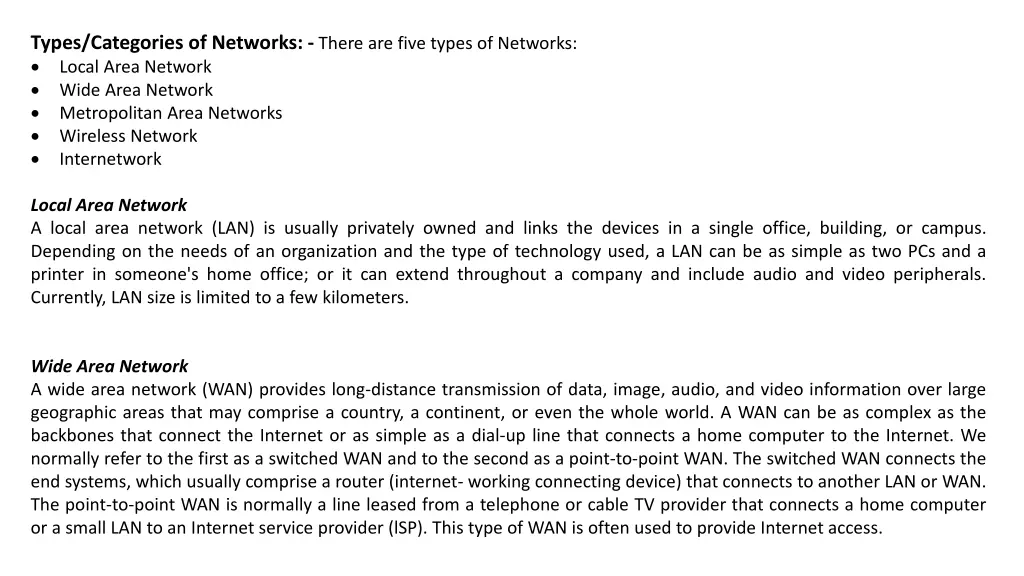
Exploring Types of Networks - LAN, WAN, MAN, Wireless, Internetwork
Discover the various types of networks, including LAN, WAN, MAN, wireless, and internetwork, each serving unique purposes and connectivity needs. Learn about transmission modes like parallel and serial for efficient data transfer.
Download Presentation

Please find below an Image/Link to download the presentation.
The content on the website is provided AS IS for your information and personal use only. It may not be sold, licensed, or shared on other websites without obtaining consent from the author. If you encounter any issues during the download, it is possible that the publisher has removed the file from their server.
You are allowed to download the files provided on this website for personal or commercial use, subject to the condition that they are used lawfully. All files are the property of their respective owners.
The content on the website is provided AS IS for your information and personal use only. It may not be sold, licensed, or shared on other websites without obtaining consent from the author.
E N D
Presentation Transcript
Types/Categories of Networks: - There are five types of Networks: Local Area Network Wide Area Network Metropolitan Area Networks Wireless Network Internetwork Local Area Network A local area network (LAN) is usually privately owned and links the devices in a single office, building, or campus. Depending on the needs of an organization and the type of technology used, a LAN can be as simple as two PCs and a printer in someone's home office; or it can extend throughout a company and include audio and video peripherals. Currently, LAN size is limited to a few kilometers. Wide Area Network A wide area network (WAN) provides long-distance transmission of data, image, audio, and video information over large geographic areas that may comprise a country, a continent, or even the whole world. A WAN can be as complex as the backbones that connect the Internet or as simple as a dial-up line that connects a home computer to the Internet. We normally refer to the first as a switched WAN and to the second as a point-to-point WAN. The switched WAN connects the end systems, which usually comprise a router (internet- working connecting device) that connects to another LAN or WAN. The point-to-point WAN is normally a line leased from a telephone or cable TV provider that connects a home computer or a small LAN to an Internet service provider (lSP). This type of WAN is often used to provide Internet access.
Metropolitan Area Networks A metropolitan area network (MAN) is a network with a size between a LAN and a WAN. It normally covers the area inside a town or a city. It is designed for customers who need a high-speed connectivity, normally to the Internet, and have endpoints spread over a city or part of city. A good example of a MAN is the part of the telephone company network that can provide a high-speed DSL line to the customer. Another example is the cable TV network that originally was designed for cable TV, but today can also be used for high-speed data connection to the Internet. Wireless Networks The fastest growing segment of the computer industry is the mobile computers such as notebook computers and personal digital Assistant (PDA). The wireless networks are becoming increasingly important because the wired connection is not possible in cars or aero planes. Wireless networks can exits on trucks, buses,taxies etc. They are used where the telephone systems are destroyed in the event of disasters such as fires, floods and earthquake etc. wireless LAN is another example of wireless networks. Internetwork Today, it is very rare to see a LAN, a MAN, or a LAN in isolation; they are connected to one another. When two or more networks are connected, they become an internetwork, or internet.
Transmission Mode The transmission mode decides how data is transmitted between two computers. The binary data in the form of 1s and 0s can be sent in two different modes: Parallel and Serial. Parallel Transmission
The binary bits are organized into groups of fixed length. Both sender and receiver are connected in parallel with the equal number of data lines. Both computers distinguish between high order and low order data lines. The sender sends all the bits at once on all lines. Because the data lines are equal to the number of bits in a group or data frame, a complete group of bits (data frame) is sent in one go. Advantage of Parallel transmission is high speed and disadvantage is the cost of wires, as it is equal to the number of bits sent in parallel. Serial Transmission In serial transmission, bits are sent one after another in a queue manner. Serial transmission requires only one communication channel.
Serial transmission can be either asynchronous or synchronous. Asynchronous Serial Transmission It is named so because there is no importance of timing. Data-bits have specific pattern and they help receiver recognize the start and end data bits. For example, a 0 is prefixed on every data byte and one or more 1s are added at the end. Two continuous data-frames (bytes) may have a gap between them. Synchronous Serial Transmission Timing in synchronous transmission has importance as there is no mechanism followed to recognize start and end data bits. There is no pattern or prefix/suffix method. Data bits are sent in burst mode without maintaining gap between bytes (8- bits). Single burst of data bits may contain a number of bytes. Therefore, timing becomes very important. It is up to the receiver to recognize and separate bits into bytes. The advantage of synchronous transmission is high speed, and it has no overhead of extra header and footer bits as in asynchronous transmission.
